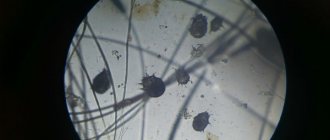Can cats get piroplasmosis?
Most veterinarians will confidently answer this question - no, cats do not suffer from piroplasmosis. At the same time, they will keep in mind that neither in theory nor in practice have they encountered this disease in cats.
But the question did not arise out of nowhere. There are cases in our country, not many of them, about two dozen over the last decade, when veterinary specialists describe their identification of the alleged causative agent of piroplasmosis in the blood of cats. At the same time, animals with corresponding clinical symptoms were studied, that is, general symptoms inherent in piroplasmosis in different animal species.
Whether this is actually true is difficult to say. These cases were not subjected to serious research, and such facts were not properly recorded.
We can only state that many animals suffer from piroplasmosis. Moreover, each of them is characterized by its own type of pathogen from the Pyroplasma family, the genus Babesia. Piroplasmosis, or babesiosis, which is the same thing, affects dogs, sheep, cattle, horses, pigs, and other types of animals, and humans also suffer from babesiosis.
Piroplasmosis occurs in large wild predators of the cat family. The first information about the disease in predatory cats began to appear at the end of the last century. A previously unknown causative agent of feline piroplasmosis, named Babesia felis, was identified and described. It is transmitted by the ixoid tick Haemophysalis leachi. Lions, tigers and other species of wild large cats are susceptible to the disease.
There is information about the detection of this pathogen in domestic cats in countries such as Thailand, France, Zimbabwe, and Israel. In Russia, as already mentioned, there are about two dozen cases where doctors claim to have detected piroplasmosis in cats, although there is a high probability of error in diagnosis.
It is now impossible to say with certainty whether domestic cats suffer from piroplasmosis, but if we assume this possibility, it is important to know how it can occur, what symptoms are accompanied by it, and what diagnostic methods are used to identify piroplasmosis.
The causative agent of the disease enters the body of animals when bitten by ixoid ticks; each animal species has its own type of carrier. In our country, in cats, with a high degree of probability, it may be the ixoid tick Rhipicephalus sanguineos.
Prognosis of piroplasmosis in cats
Regardless of the form in which the disease occurs (acute or chronic), the cat tolerates it very hard. Recovery depends entirely on the body, or rather on the immune system. If the pet's immunity is strong, the body will have to overcome the parasites. A young body is able to cope with the disease faster.
Without proper treatment, your cat will develop serious complications. Red blood cells die en masse, macrophages cannot cope with so many dead cells, and all this leads to the following consequences:
- Kidney failure, which occurs when groups of dead blood cells form clots that clog the kidney tubules.
- As you know, red blood cells transport oxygen to all tissues and take away carbon dioxide. The fewer red blood cells there are, the less oxygen there will be in the body.
- The most dangerous thing is that intoxication occurs due to a large number of red blood cells, and ultimately death.
- Acute pancreatic insufficiency develops
- Acute liver failure develops
- Splenitis (inflammation of the spleen) may begin.
If piroplasmosis becomes severe and symptoms of complications appear, then treatment and recovery of the body will be greatly delayed. But sometimes, the chronic stage can end with an unexpected recovery after several months of suffering for the pet.
An important point is to follow all the doctor’s recommendations after treatment, including limiting the pet’s mobility for 7-10 days (do not climb trees, do not jump around yards). This is the only way to prevent a relapse.
What happens after a bite?
Ixoid mites are intermediate hosts for parasitic protozoa of the piroplasma family. In the tick's body, piroplasms undergo part of their development cycle.
The causative agent of piroplasmosis enters the animal’s bloodstream, when bitten, with the tick’s saliva, and begins to multiply intensively in the red blood cells.
Red blood cells die en masse, releasing hemoglobin. Hemoglobin is partially removed in the urine, turning it red, and is partially converted into bilirubin, resulting in yellowness of the mucous membranes and eyes.
The number of red blood cells in animals with piroplasmosis is reduced by 2-3 times compared to the normal level. As a result, severe anemia develops - anemia, which entails, as a compensatory reaction, increased breathing and pulse, and increased heart contractions. Excessive stress on the heart muscle leads to cardiac hypertrophy.
Toxic products accumulate in the blood and tissues, metabolism is disrupted, and inflammatory and degenerative processes occur in the spleen, liver and kidneys. Acute kidney failure develops.
Symptoms of piroplasmosis in cats
Once in the bloodstream, Babesia penetrates erythrocytes - red blood cells, and begins to actively multiply in them. Parasites of large and small livestock divide twice, and as a result, from 1 parasite you get 4; canine Babesia divide only in two, and cat Babesia can divide in both ways. Reproduction of piroplasms leads to the death of red blood cells.
They break up into fragments, the blood is filled with free bilirubin, which poisons the animal. The bone marrow does not have time to reproduce red blood cells to replace the dead ones, and as a result, anemia increases in the animal.
A lack of blood cells leads to the fact that all tissues of the body, including vital organs, do not receive enough oxygen. As a result, the function of the kidneys, liver, and brain is impaired. All organs and systems of the body fail. This is the reason for the death of the animal.
The clinical picture of piroplasmosis in dogs is well known to owners. This is yellowness of the mucous membranes and sclera, orange feces, darkening of urine, high temperature. It looks like cow and sheep babesiosis. But piroplasma infection in cats looks completely different.
- Fever is extremely rare.
- Jaundice almost never occurs.
- Symptoms of anemia come to the fore: the mucous membranes are white, the animal is lethargic.
- Dyspnea and tachycardia are common.
Without treatment, the disease ends in the death of the animal due to increasing anemia.
How to understand that a cat is sick with piroplasmosis?
The disease usually occurs in an acute form, characterized by rapid development and intensity of all symptoms:
- Increase in temperature in cats, up to 41-42 C;
- Dyspnea. Breathing is rapid and labored;
- Yellowness of the mucous membranes and whites of the eyes develops;
- Urine acquires a red tint, of varying intensity, even brown;
- The animal is depressed, there is no appetite, diarrhea and vomiting may occur;
- The animal exhibits muscle weakness, an unsteady gait, weak hindquarters, and may develop paresis of the hind limbs.
Less commonly observed is a slower and less intense course of the disease - subacute and chronic forms. In this case, the symptoms are less pronounced, and some of them may be absent. Characterized by anemia and gradual exhaustion.
Treatment of piroplasmosis in cats
The treatment regimen for feline piroplasmosis is the same as for all blood parasitic infections. First of all, an antiprotozoal drug is prescribed that will kill the Babesia. The antimalarial drug primaquine phosphate is successfully used in cats, but caution is used: the lethal dose of this drug is only 2 times higher than the therapeutic dose. There is evidence of a cat being cured using a combination of imidocarb and doxycycline.
The second task is to relieve intoxication, which is caused by the death of red blood cells and the immune response to their introduction into the body. For this, infusions (droppers) are used to help remove toxins through the kidneys.
The third is symptomatic therapy, which can include anything from antiemetics to blood transfusions.
The fourth is monitoring the harm that the disease has caused to the animal and correcting disorders of the internal organs.
As a result, the treatment regimen for feline babesiosis is extremely individual and must be worked out for each specific case, taking into account the cat’s condition.
Establishing diagnosis
Preliminary diagnosis is based on the presence of specific clinical signs and is confirmed by laboratory tests.
Laboratory methods are used to make a diagnosis:
- Microscopy;
- Serological examination of blood serum;
- PCR.
Microscopic examination of blood smears, with Romanovsky staining, and serological examination are of decisive importance. The PCR reaction helps identify the pathogen and clarifies the results of other studies. A general blood test shows compositional changes characteristic of this disease.
Symptoms and first signs
When describing the symptoms, refusal to feed comes first. The following are:
- oppression;
- feverish increase in temperature;
- vomit;
- diarrhea alternating with constipation;
- pica;
- cough and sneezing;
- difficulty breathing.
The danger of the disease is due to the fact that symptoms do not appear for a long time, and when the symptoms are already visible, it is too late.
Remember! Animals suffer from the disease and the mortality rate is very high.
Disease prevention
The basis of prevention is treating the animal with acaricidal agents and avoiding tick bites. After walking your cat in an unfamiliar place, you should inspect its fur and skin!
Vaccines against piroplasmosis exist, but their effectiveness remains unproven.
First of all, protection against ticks in the spring and autumn comes to mind. That’s right - whoever is protected is armed! These include drops (Bars), sprays (Frontline, Fipron), ointments (Bars), and special shampoos, gels (Avanpost), and even collars (Bars) that have a repellent effect. You need to look for them in a veterinary pharmacy, after consulting a doctor.
Treat the cat according to the instructions for each such drug and the recommendation of a specialist. It must be remembered that an animal can become infected more than once with this insidious disease. Therefore, treatments should be regular and annual. Last but not least is strengthening the immune system. A good supporting remedy is echinacea mixture and vitamin complexes.
There is no vaccine that provides a 100% guarantee.
We invite you to read: Symptoms of giardiasis in cats Treatment regimen for giardiasis in cats
The main preventive measures are treating the animal with acaricidal agents and preventing ixodid tick bites. The drugs can be in the form of a spray (they begin to act immediately after treatment) and in the form of drops on the withers (it takes a day to activate). Protective shampoos and acaricidal collars will also help prevent piroplasmosis in cats.
Do not let your cat go for a walk in an unfamiliar place or forest; after a walk, carefully examine the animal - ticks are difficult to see under thick fur.
In addition, there are vaccines against piroplasmosis, but their effectiveness has not yet been reliably proven.
So, modern scientists were able to get an answer to the question: “Do cats get piroplasmosis?” Unfortunately, the answer is yes. Therefore, during the period of tick activity, cat owners should pay great attention to the prevention of this serious disease, the outcome of which can be fatal.
To prevent your pet from becoming infected with piroplasmosis, it is necessary, first of all, to protect it from attacks by ixodid ticks. Therefore, for a walk, it is better to choose places where the likelihood of these blood-sucking insects appearing is extremely low, for example, a sunny meadow blown by the wind. It is better to walk with the animal at noon, when the bloodsuckers are hiding and not hunting.
To bite, insects usually choose areas where the skin is thinnest—the inner thighs and abdomen. If a tick has attached itself to the neck under the lower jaw, the vigilant owner will immediately notice this, since the pet will begin to scratch the bitten area.
But the correct choice of place for a walk and subsequent inspection of the animal to detect a tick, unfortunately, will not prevent infection if the insect ends up on the pet’s body. Therefore, the most effective preventative measure is to treat the cat’s skin and fur with acaricides, which neutralize the insect, causing paralysis of its limbs.
Chemical treatment against ticks is carried out during the warm period - from May to September. Drugs containing permethrin prescribed in such cases for dogs and mustachioed pets are not suitable - such drugs are too toxic for them.
Sprays or drops containing fipronil are used to treat furry pets. An adult cat is treated 24 hours before a planned walk in the park/forest. The product is applied to the withers area so that the pet cannot lick it off. The active substance accumulates in the sebaceous glands under the skin without entering the blood. The effect lasts for a month.
Piroplasmosis in cats, the symptoms of which appear 1.5-2 weeks after infection, is a rather dangerous disease. If you do not seek help from a veterinarian in time, the animal may die. Since Babesia enters the body of a pet through the bite of an ixodid tick, measures should be taken in advance, that is, before the onset of the warm season, to protect the animal from these blood-sucking insects.
The presence of piroplasmosis in domestic cats is not a particularly proven fact, but there are other blood parasites transmitted by ticks that can cause serious systemic disease. Therefore, we should talk about the prevention of, if not babesiosis, but at least anaplasmosis and theileriosis, which together belong to one general group of vector-borne diseases - hemosporidosis.
First of all, to prevent the possibility of infection, they try to protect the animal by all means from attacks and tick bites. Protection is provided with the help of acaricidal spray, drops, injections, and a collar.
It is advisable to work according to the following scheme during the season (spring, autumn) when ticks are active: use drops (according to the instructions, they are applied to the skin along the withers; the acaricide is effective for 4-6 months), and when going outside, the cat is additionally treated with a spray.
After a walk, the animal is carefully examined for the presence of ticks. All detected insects are removed using tweezers and burned. Under no circumstances should the tick be pulled off, only carefully twisted out.
In the future, you should carefully monitor the animal’s condition; any deterioration is an alarm that requires an immediate visit to a veterinarian and a full examination of the cat.
KotoDigest Thank you for subscribing, check your inbox: you should receive an email asking you to confirm your subscription
Today, not only veterinarians, but also competent breeders know whether piroplasmosis occurs in cats. This cannot but rejoice, since he who is forewarned is forearmed. Knowing about the danger, you can take preventive measures in time. With the onset of the first warm days, you need to put on a special anti-flea and tick collar for your pet.
An additional means of protection that can be used in parallel are drops on the withers. If you are going to the dacha with your cat, then take a bottle of anti-tick spray with you. The treatment must be done at home so that the drug has time to be absorbed. This will provide protection for up to five days.
Don't forget to check your pet for fleas and ticks after every walk. Found insects must be removed and destroyed. If the ixodid tick has managed to attach itself, then it is better to immediately go to the veterinary clinic. The specialist will not only remove it from the body, but also analyze it for infection.
What you need to pay attention to:
- lethargy, drowsiness;
- change in urine color, it becomes dark in color
- lack of appetite;
- fast heartbeat;
- fast breathing;
- fever;
- anemia;
- unexplained weight loss.
In addition, sick cats experience disruptions in the gastrointestinal tract, which is manifested by nausea, vomiting and diarrhea. The owner should notice that the urine has changed color from yellow to dark brown and begins to smell unpleasant. An infected pet will begin to react poorly to everything that happens around it, sleep often and hide in a secluded and quiet place in the house. Temperatures may rise to 41 degrees.
Since parasites lead to the death of red blood cells, this will be externally manifested by pallor of the oral mucosa and anemia. The cat may also develop tachycardia, arrhythmia and shortness of breath.
If you do not respond to the first symptoms in time, a complication appears:
- blood when urinating;
- atony in the intestines;
- breathing becomes difficult;
- HR (heart rate) slows down;
- paralysis.
Piroplasmosis in cats develops at lightning speed. In more severe cases, when signs of complications are already noticed, the death of the pet may occur on the second day. That is why, when the first symptoms appear, it is important to immediately contact a veterinarian and take an urgent blood test.










